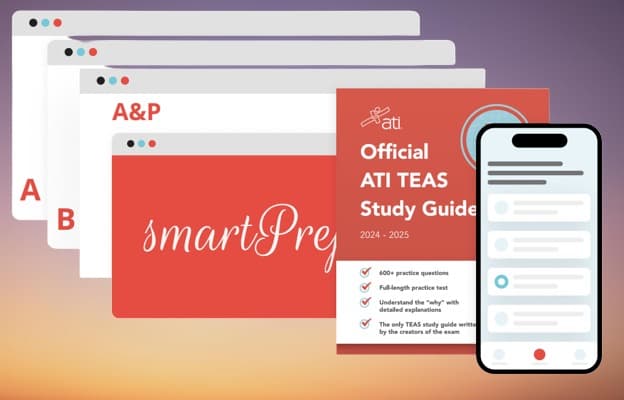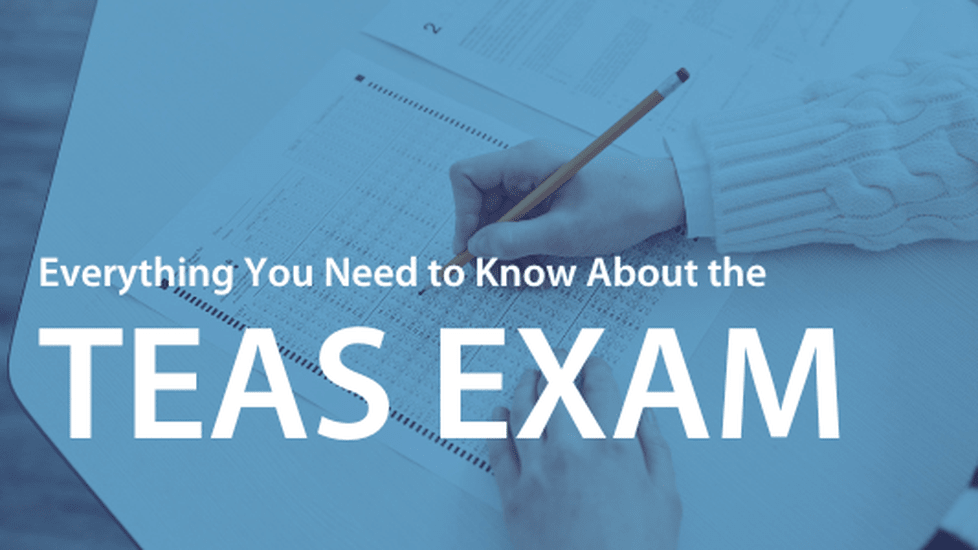Introduction
A robust TEAS test study schedule is vital as it improves your chances of admission to competitive nursing programs. A well-rounded TEAS test study plan will have a content review, a review of weak areas, and practice tests.
It will also help you allocate time appropriately to work on those weak areas. This article covers essential aspects such as assessing your knowledge, creating a personalized study schedule, and having the right study resources. Read on for more insights.
Here is a step-by-step process for creating a remarkable TEAS test study plan:
- Identify your objectives and set SMART goals—First, you must clearly define what you want to achieve by creating this study plan. Then, determine the sections and topics to focus on and have clear SMART (Specific, Measurable, Attainable, Realistic, Timely) goals for each section. Some of the objectives could be understanding calculus, proportional ratios, algebra, or equations and inequalities topics.
- List the sections and topics—Write down a list of all the sections you plan to cover. Ensure you prioritize them based on the amount of time required and difficulty. They could be topics in biology, such as cell structure, or chemistry, like chemical bonds and acids and bases.
- Allocate time for each section – Create different time slots for reviewing notes, reading, and practice tests. More challenging subjects and topics should have more time than easy ones. As for maths, allocate around two to three hours for every challenging topic, such as geometry or statistics. The easier topics in subjects such as biology or reading could take an hour and a half each.
- Identify your unique learning style and use it. Some students prefer learning by reading books, others by watching videos, and others will understand concepts better by doing many practice questions. Identify what works well with you and use it to your advantage.
- Review and adjust—Ensure you regularly review your study plan and progress to see whether it works for you or against you. Adjust accordingly, accommodate any changes in your schedule, and focus on challenging topics requiring more attention.
Below is a sample TEAS test study plan you can draw inspiration from:

Sample Study Plan
Week 1
Monday: Review Reading strategies for around two hours from 11 a.m. to 1 p.m. These may include previewing the texts, active reading, chunking, and summarizing. From there, you can take a practice exam for about one and a half hours from 2 pm to 3.30 pm. It will help familiarise you with the exam structure and question style.
Tuesday: Study numbers, algebra, measurements, and data, and devote around two hours to these topics. This could be between 9 am and 11 am. You could also finish with a one-hour math practice test to assess how well you understood the concepts.
Wednesday: From 8 a.m. to 12 noon, review science concepts, including human anatomy, genetics, and DNA. Ensure you understand the specifics and ideas in these topics. Use online resources like websites and TEAS revision textbooks to find information.
Thursday: Read the English Language Usage rules on punctuating and creating meaningful sentences. Ensure you also take a practice test to determine whether you understand the concepts. Time: 11 a.m. to 3 p.m.
Friday: On Friday, you can take one hour to review each of the four sections of the TEAS test. In the first hour, start with math, look for the most tested topics, and do some practice questions to see whether you have mastered the concepts. In the next hour, you could do the same for Science, the next for reading, and the English language and usage section.
Week 2
Monday: Focus on the reading section this day, learn about integrating knowledge and ideas, craft and structure, and review areas that require improvement. This should take place from 8 a.m. to 12 noon.
Tuesday: On this day, you could focus on math—fractions, decimals, and percentages—from 9 a.m. to 1 p.m. From 2 p.m., you could take a practice test for around 2 hours to familiarize yourself with the exam setting.
Wednesday: From 10 a.m. to 2 p.m., study the chemical properties of water, the endocrine system, and kinetic and potential energy. Examine areas for improvement on these topics and work on them.
Thursday: Look for weaknesses in the English language usage on Thursday. Find out how to use question marks and speech marks and create a sensible paragraph. You could spend around 2 or 3 hours doing that from 11 am to 4 pm.
Friday: Take two hours to review individual sections of the TEAS test. In the two hours, ensure you master the challenging topics and concepts, whether it is in the math or science section. This is also the day to take a full-length practice exam of about 3 hours from 2 pm to 5 pm.
Week 3
Monday: From 9 am to 12 noon, take on the science section of the TEAS exam. Endeavor to cover scientific measurement and fundamental physics principles like energy, electricity, and magnetism. Capture all crucial concepts in these topics.
Tuesday: Study health and nutrition, microbiology, and some chemistry topics, including chemical bonding and reactions. This should take around five hours, from 8 am to 1 pm.
Wednesday: Take on the math section and cover decimals, fractions, percentages, statistics, and geometry. These technical topics could take about 6 hours, from 9 am to 3 pm.
Thursday: Handle the reading section for about 2 hours from 8 am to 10 am, including passages on humanities, social sciences, and literary analysis. In the afternoon, I handled the English and language usage section on contextual understanding, vocabulary, word usage, grammar, and sentence structure topics for three hours, from 2 pm to 5 pm.
Friday: It is practice test day. Take three hours for every section of the TEAS test. Start with math from 8 a.m. to 11 a.m., take an hour break, and then handle the science practice test from 12 noon to 3 pm. Finally, take the reading section from 4 pm to 7 pm.
Week 4
Monday: From 8 a.m. to 11 a.m., tackle the English language and usage section on spelling and punctuation. You could have another two hours in the afternoon to review any challenging concepts in science, especially the topics of scientific measurement and scientific terminology, from 3 p.m. to 5 p.m.
Tuesday: Work on math topics including geometry, probability, measurement, order of operations, and data interpretation for 4 hours from 10 am to 2 pm.
Wednesday: Handle science topics, including anatomy and physiology, health and nutrition, microbiology, and basic scientific terminology, for 3 hours from 8 am to 11 am.
Thursday: You could tackle the reading section for about four hours on this day. Ensure you look at the context clues, reading connections, visualization, and chunking topics. Exhaust these areas and find areas that challenge you.
Friday: On the last revision day, endeavor to take several practice tests for the TEAS test sections. Take the English and language usage section practice test for around 3 hours from 8 am to 11 am. Then, polish up on the maths, science, and reading sections since you handled the tests last Friday afternoon. This could take 4 hours from 2 pm to 6 pm.
Importance of a Study Plan
Adequate preparation will lead to your success in the test, starting with a concise study plan. But how important is the study plan to a student preparing for the TEAS test? Find out below:
- Time management – A well-planned study plan helps you manage your time better by establishing realistic goals and deadlines for finishing your study sessions. Creating a study guide can help you avoid cramming and guarantee that you have enough time to cover all subject topics before the exam.
- Prioritization – An effective study plan is essential for prioritizing your efforts by identifying areas for improvement and allocating more time and effort to these topics. Prioritizing allows you to focus on the most critical aspects, such as your weaknesses, to attain your desired score.
- Organization—Having a sound strategy/plan keeps you from becoming disoriented. It keeps you organized by chunking topics into smaller, more digestible portions and tracking your learning progress. It keeps you from feeling overwhelmed and guarantees you cover all relevant material before your exam.
- Motivation – A study plan keeps you motivated by establishing clear goals and milestones and rewarding yourself for meeting them. It helps you stay focused and committed to your studies, which is critical for success.
How To Select the Right Study Resources
The proper study resources will help you prepare adequately for the TEAS test. These resources will have all the information and insights you need to understand the test’s content, the number and nature of questions, and the time allowed for each section. But what are the proper study resources?
Candidates can utilize three study resources when preparing for their TEAS test. These include online courses, books, and practice tests. Books offer the aspirants a comprehensive guide with practice exams and practice test questions. The most reliable books will cover all sections of the TEAS test, including mathematics, English and language usage, reading, and science.
Aspirants should look for reliable online courses when seeking help to prepare for the TEAS test. The platform should offer dynamic TEAS exam preparation with online practice assessments and quizzes. It should also have more information on how to tackle the exam, what to do when faced with a challenging question, how long to take in a given section, and even how to interpret your results.
Practice tests are another brilliant resource when preparing to take the TEAS test. These tests help students identify their strengths and weaknesses in the TEAS exam. The practice tests should also be timed to allow students to get used to the time constraints when doing the TEAS test. Visual learners could look for video lessons from reputable sources to gather as much information as possible about the exam.
How To Evaluate the Quality and Effectiveness of Study Resources
It would be best to consider some parameters to tell whether the resource you choose to work with is reliable. Here are some issues to look at before settling on a given resource:
- Practice questions and tests—A practical resource should offer aspirants practice tests with a format similar to and complex to the TEAS test to assess their readiness.
- Content coverage – the study resource should extensively cover all four areas in the TEAS test.
- Study schedule guidance: Look for a reliable resource to help you organize a TEAS study plan tailored to your availability and test date.
- Diagnostic tools – choose a study resource that includes diagnostic tools in the package, such as diagnostic tests, to help understand your strengths and weaknesses.
- User-friendliness and accessibility: Study materials should be easy to navigate and access, with clear instructions and user-friendly interfaces.
- Relevance and updated content—The study resource should contain up-to-date information relevant to the TEAS test and not old topics that are no longer examinable.
It is advisable to combine different study resources when creating a TEAS test study plan. Other resources will offer you a comprehensive approach and dynamism that you will not get from one source. Combine the practice tests and questions from different platforms to see how they structure the tests and what questions they examine. Use video study materials to visually represent the tests and acquaint yourself with almost the actual paper.
How To Organize Your Study Sessions
The best way to organize your study schedule is to break it down into chunks.
- Break down material—To avoid being overwhelmed by the enormous workload, consider breaking down your study material into manageable chunks. Focus on each section at a time, whether it is the reading or science section. Break down the section further into topics and subtopics to have enough time to cover every aspect of the topic extensively.
- Create a conducive study environment—Learning requires a conducive environment to absorb information. Consider getting a quiet place with little to no distractions while studying. Ensure you are comfortable with your study space, maintain proper posture, and get ergonomic support for your study chair for a conducive and productive study environment.
- Use active learning strategies—these will help you retain information better and make studying more engaging. Use concept mapping, practice problems, and flashcards to understand critical concepts. Create concept maps to visualize how different concepts relate, use flashcards for math formulas or vocabulary words, and practice problems to better your problem-solving skills.
Use these three ideas to make the most of your TEAS test study schedule and improve your chances of success in the exam.
How To Track Your Progress
Below are tools, strategies, and methods to help you track your progress effectively:
- Monitor performance and comprehension: Regularly review the practice test results and study notes. This will allow you to understand your weak areas and substantial sections, thereby placing more emphasis on the weak areas. Use self-assessment quizzes to gauge your level of understanding of the key concepts.
- Use apps and tools for tracking study hours and milestones—Aspirants should also use apps that offer project and task management features to monitor their progress. Time-tracking apps will help track study hours and analyze productivity levels. Get project tracking software, as it will also assist in managing study tasks and deadlines.
- Strategies for adjusting the study plan: Ensure you regularly review the study schedule and adjust it according to the feedback and progress you make. Modify the TEAS test study plan to allocate more time to improvement areas. Use feedback from the practice tests to understand where you went wrong in a specific section, and then look for material that expounds more on that challenging question.




